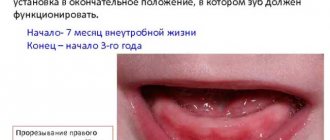The problem occurs several weeks before the eruption of a baby or permanent tooth. The appearance of a cyst is indicated by a bluish-purple spot (hematoma). This is due to difficulty in tooth eruption.
An eruption cyst is a type of soft tissue benign tumor that appears when a tooth has already begun to erupt through the gum. Scientists and doctors have not agreed on why it occurs. The most likely causes: infection, trauma, improper development of teeth, which causes a lack of space for the “newbie”. In addition, it may be a consequence of caries and improper care.
Eruption cysts occur during the growth of baby teeth or, more often, at 6–9 years of age, when permanent teeth emerge. The fact is that, due to its anatomical structure and location, the chewing group of teeth is the most difficult to erupt.
If you notice a large formation in your baby’s mouth, in the place where a tooth should appear, consult a doctor. Do not resort to self-medication under any circumstances. Infusions, rinses and even strong antibiotics most likely will not help, but ruining a child’s health in this way will cause serious harm.
If you contact a specialist, treatment can follow one of two scenarios. In the most favorable option, the doctor will advise giving the child toys, special teethers, crackers - everything that the baby can chew. This will help break through the mucous membrane.
In difficult situations, surgery may be necessary. Then the surgeon will cut the gum under local anesthesia. This will make teething easier.
It is forbidden to try to cut or tear the mucous membrane on your own; you can cause a serious infection or injure your baby.
Causes of Teething Cysts in Children
During teething, a hematoma is formed; it occurs due to the fact that the tooth cannot break through the mucous membrane and thereby injures the gums and ruptures blood vessels. The longer the formation is in the oral cavity, the larger its size; in addition, the amount of swelling will depend on the group affiliation of the tooth.
The main causes of the tumor:
- pulpitis;
- caries;
- periodontitis;
- improper tooth treatment or lack thereof;
- eruption injuries.
The baby’s body tries to limit the source of infection, which is why a dense protective capsule is formed, which eventually develops into a cyst. The occurrence of such formations is quite common. An infection caused by carelessness, an unsuccessful attempt to chew hard food, a fall that led to a tooth injury - all this can serve as a starting point for gum inflammation and further development of a cyst.
Another fairly common mistake parents make, which can lead to the appearance of a tumor during teething, is negligence in caring for baby teeth.
It is generally believed that you should take serious care of your dental health after changing them. Since there is no point in treating non-permanent baby teeth - they will soon fall out. In fact, not taking things seriously leads to many problems. Any gum diseases and oral infections should be eliminated in a timely manner, regardless of how many teeth the baby has and whether they are permanent or not.
Why gums may turn blue
Experts identify a large number of factors that can affect the condition of the gums.
Reasons for discoloration of gums in a child:
- Eruption of baby or molar teeth. Due to strong mechanical pressure on the soft tissue vessels, a blue hematoma appears.
- Bruise or cut. Due to mechanical trauma to the gums, a blood clot accumulates at the site of the bruise, causing the gums to turn blue.
In an adult, soft tissues may change color for the following reasons:
- Improper functioning of the cardiovascular system;
- Kidney diseases;
- Problems with the thyroid gland;
- Inflammatory diseases of teeth and gums: gingivitis, periodontitis, periodontal disease, herpetic and candidal stomatitis, which are accompanied by increased accumulation of bacterial plaque on the enamel.
- Carious formations localized in the cervical area of the tooth.
- Errors in orthopedic treatment. An incorrectly made crown or denture reduces blood flow along the gingival margin, which causes the periodontium to turn blue. In this case, the color change occurs due to a violation of the blood supply to the soft tissues.
- Surgical interventions. After tooth extraction, the soft tissue in the area of the formed hole may turn blue.
- Burns (regular thermal or chemical burns). A chemical burn can occur due to contact with the mucous membrane of an aggressive substance that is used in the treatment of root canals.
Complications with cyst growth
Tooth trauma, advanced caries, nasopharyngeal or periodontal disease, dental malformations - one or more of these factors can lead to the development of a cyst. The danger is that the cyst grows unnoticed. It usually does not hurt and at the initial stage does not cause discomfort or reaction of the lymph nodes. With further development, suppuration and various unpleasant sensations may appear. But even if there is no pus, the cyst is very dangerous. Therefore, do not delay treatment.
A cyst can lead to intoxication of the body due to the fact that waste products of harmful microorganisms enter the blood. The consequence of this can be headaches, high fever and, in the worst case, sepsis.
In addition, complications are caused by local problems - phlegmon, abscesses, osteomyelitis. These complications are inflammatory in nature and often occur when the cyst suppurates. The spread of pus can lead to destruction of the jaw bones, damage to the internal organs of the digestive system, liver, and heart.
It is impossible to avoid the appearance of a cyst, but if you properly care for baby and permanent teeth and treat infections in a timely manner, you can reduce the likelihood of its occurrence. In addition, periodic visits to the dentist will allow you to notice the problem at an early stage, when treatment will be as simple and easy as possible for the body.
What to do if a child has a lump on his gum near a tooth?
A lump on a child’s gum can have a different appearance, which is well demonstrated by the selection of photos. With such a problem, you should definitely consult a doctor. Self-medication is strictly prohibited. This can only aggravate the pathological process.
The specialists of the Shifa dental clinic will help you understand the causes of compaction on the gums and provide qualified assistance in full. In the clinic, all dental procedures are performed under anesthesia, so the child will not experience negative emotions during treatment. Contact the best dentists! You can make an appointment at the Shifa clinic by phone or through the form on the website.
Cyst treatment
A dental cyst is treated either with therapeutic methods or with surgical intervention. The first ones are used in simple cases.
Surgery involves two types of operations - cystotomy and cystectomy. In both cases, local anesthesia is used. With cystomy, only the anterior wall of the cyst is removed. This is a less traumatic option, as it allows you to preserve the rudiments of permanent teeth during surgery on milk teeth.
Cystectomy is performed if the size of the cyst does not exceed 1.5 cm. This operation is more difficult, but postoperative recovery is much faster.
No matter how small and insignificant the swelling may seem to you, contact your dentist. This will avoid complications. And the problem will be resolved more easily and in a short time. Remember that no rinses, infusions or other folk remedies can guarantee recovery.
Main reasons
Why can one or more teeth turn blue? There may be several reasons for this; sometimes there is nothing dangerous to health in this process, and sometimes this is a reason to urgently seek advice from a dentist. A change in shade is possible due to poor quality nutrition or adherence to a strict diet. This can also happen if you eat a lot of fresh berries, such as blueberries, blueberries or blackberries.
Newly installed fillings may differ in color from natural tissues. A pulpless, that is, dead tooth can also change its color. This is explained by the fact that when the pulp is removed, nutrients stop flowing to the tissues.
If a seemingly healthy tooth begins to turn blue, this may indicate that there are problems with the root system. This is usually preceded by serious dental diseases. In addition, the cause of blue enamel may lie in the patient’s body; this phenomenon may be caused by the presence of chronic diseases or problems with the digestive system. Another common reason is the use of low-quality water with high levels of iron.
How to avoid complications
To avoid missing a cyst in the early stages, check with your dentist at least once every six months, especially if your child has chronic pulpitis or periodontitis. The occurrence of cysts is most likely between the ages of 6 and 12 years, especially during the formation of the first molars in the lower jaw.
Teach your child proper and regular oral hygiene. This will reduce the likelihood of inflammation and caries in both milk and permanent teeth. For this, use high-quality children's toothpaste for a specific age. Asepta has developed Baby, Kids and Teens pastes that take into account the dental needs of children of different ages. For the little ones, specialized Asepta wet wipes designed in the form of finger pads are suitable - wipe the gums after each feeding.
It is necessary to treat infections and caries in a timely manner so that they do not lead to the formation of a cyst in the future.
Treatment of blue teeth
If during diagnostics it is determined that the cause of blueness of all teeth is the use of special products, the dentist or hygienist may prescribe a professional cleaning of the oral cavity. Quite often the patient requires enamel polishing; this allows for the best results.
If after such manipulations the blue discoloration does not disappear, you can try other methods.
First of all, the doctor should send the person for an X-ray examination of the jaw, this will make it possible to make a correct diagnosis, as a result of which the treatment will be as effective as possible. It may also be necessary to remove previously installed fillings and caries-infected hard tissues. If necessary, treatment of the annals and root system of the tooth will be prescribed.
There are several methods to restore the original whiteness of your teeth. One of the most common options is the installation of a composite filling, that is, direct artistic restoration of a row. A more expensive procedure is the production of an artificial crown or special onlays - veneers (indirect restoration).
How to make teething easier
While the teeth are just getting ready to appear, the baby experiences a lot of unpleasant sensations, which, of course, causes a lot of trouble for the parents. During this period, the child needs care and affection, as well as plenty of fluids. It is recommended that infants be breastfed more often, and children on artificial nutrition should be offered more warm water.
There are many ways to relieve discomfort. Two most popular:
- Give your child special teethers - these are soft silicone toys filled with liquid. Cool the toy slightly in the refrigerator before use. This will help relieve swelling and reduce pain. The textured surface of the teether will give the baby the opportunity to thoroughly massage and “scratch” the gums. The bright design of the toy will attract attention to it and amuse the child.
- Use topical medications - pain-relieving gels and ointments for gums, designed specifically for children. These remedies act very quickly and help the child forget about discomfort for several hours.
"Shark Teeth"
During the process of root resorption, baby teeth become loose and, pushed out by growing permanent teeth, fall out. But sometimes the mechanism of this process fails. The permanent tooth has time to grow before the milk tooth that precedes it falls out.
Sometimes a whole row of such permanent teeth grows parallel to a row of milk teeth, which, for some unknown reason, do not fall out. Such teeth are usually called “shark” teeth, by analogy with the dentition of sharks, in which the teeth grow in three rows.
Studies have confirmed that “shark teeth” do not cause problems in the long term. When a baby tooth falls out, the “shark tooth” begins to shift and takes its normal place.
Associated symptoms
Gums can turn blue not only in the youngest patients, but also in adults. As a rule, this pathology is accompanied by many other symptoms. Most often, a person experiences noticeable pain, especially with accidental contact with tissue or with solid food, and the gums may swell and bleed.
If the cause of darkening or the appearance of age spots lies in the inflammatory process, the following symptoms can be diagnosed: severe fever and chills, itching and burning, the appearance of blood or purulent discharge, and others. In this case, immediate treatment is required in a dental clinic; traditional methods will not be effective.
If the cause of darkening of the gum or tooth is the incorrect installation of a prosthesis or crown, the patient may complain of pain even at rest, as well as slight tingling and numbness of the tissue (a sensation similar to what happens after the end of anesthesia).
previous post
How is a general examination at the dentist performed?
next entry
How to remove black plaque on teeth
It is impossible to remove dental plaque at home. Moreover, the use of abrasive agents and intense exposure to teeth with a brush can cause an increase in dental problems: thinning or damage to the enamel, trauma to the gums or mucous membrane.
Priestley's plaque on children's teeth can only be removed in a well-equipped dental clinic. The specialist will:
- professional teeth cleaning;
- If necessary, treat the teeth with a remineralizing composition.
If plaque formation is caused by dental problems, additional treatment may be prescribed, including bite correction.
The doctor will also select a home hygiene kit that is ideal for the child: a toothbrush of the correct shape and hardness, toothpaste with the optimal composition, and mouth rinse. Additionally, the hygienist will teach the child how to brush their teeth correctly and will talk about the need for quality oral care.
Taking into account the causes of the disease, the dentist may prescribe additional treatment measures, for example, recommend dietary supplements, dietary nutrition, avoidance of drinks and foods with dyes that affect the color of the enamel.
Memo for parents. Actions for trauma to temporary and permanent teeth in children
• In summer, the physical activity of children and adolescents is especially high - jumping, running, cycling, skateboarding and roller skating, playing outdoors and visiting rope parks sometimes lead to falls and injury to temporary and permanent teeth.
• Unfortunately, many parents do not immediately seek dental treatment for children due to injury, but only after the development of inflammatory complications or in order to eliminate aesthetic problems. Often, some injuries to the children's dental system are completely ignored by adults.
• There is a misconception that an injured temporary tooth will still be replaced by a permanent one, so it is not necessary to show the child to a pediatric dentist. Meanwhile, if a temporary tooth is injured, not only its root can be damaged, but also the germ of the permanent tooth. This subsequently leads to the development of complications such as underdevelopment of permanent tooth enamel (enamel hypoplasia), disruption of its formation, and even death of the permanent tooth germ. In the latter case, the absence of a tooth in the dentition can lead to malocclusion and the need for orthodontic treatment.
• Dear parents! Experienced pediatric dentists at the Jasmine Clinic have prepared for you a memo on the sequence of actions in case of trauma to the dental system in children and adolescents.
• Immediately after the injury occurs, it is necessary to reassure the child and not show your confusion and excitement. Set your child up in a positive way, convincing him that you know how to act correctly in such a situation.
• Try to get an appointment with a pediatric dentist as soon as possible. Call your loved ones or friends who will urgently begin searching for a qualified pediatric dentist, followed by making an appointment as soon as possible.
In such a clinical situation, the doctor will try to make a diagnosis as quickly as possible and begin measures to save the injured tooth. If the damage is serious, you need to inquire about the availability of not only a therapist, but also a surgeon in the clinic, since tooth extraction and/or suturing of soft tissue may be required.
• Ask the child whether his general condition has changed after the injury - whether there has been any memory impairment (does he remember what preceded the fall or hit an object and what happened after that), whether dizziness, flickering of “spots” before the eyes occurred, nausea, vomiting, headache. Chipping and dislocation of teeth can be accompanied by a concussion, therefore, if there is a change in the general condition, a mandatory examination by a neurologist is necessary, along with actions to save the injured or dislocated tooth.
• Examine the child's oral cavity to understand what happened to the teeth during an impact or fall. After all, even minor injuries such as chipped enamel or a bruised tooth do not go away without consequences. It is very important to see your dentist on time! Pay attention to the preservation of the soft tissues of the lips adjacent to the injured tooth, bleeding of the dentogingival groove of the injured tooth, and its displacement outside the dentition. The cause of tooth injury is usually a blow to it. And, nevertheless, injuries are different: tooth bruise, tooth dislocation (complete or incomplete), tooth fracture (at the level of enamel, dentin, dental pulp or longitudinal tooth fractures), tooth root fracture, tooth germ injury and combined injuries. The simplest of the above types of injuries can be identified immediately by a number of symptoms. If it is a tooth bruise: the child may experience pain, especially in the first hours after the injury, which intensifies when biting. If this is a dislocation of a tooth, then significant pain, which intensifies when biting, is combined with its mobility. Diagnoses of “tooth fracture”, “tooth root fracture”, “tooth germ injury” can only be made by a dentist after an X-ray examination.
• If a tooth or part of it is missing, try to find it as quickly as possible, enlisting the help of others.
• If you find a tooth or its fragment, get to the nearest pharmacy as quickly as possible, buy a test container, saline solution and miramistin. You can use milk instead of saline solution.
• Place the tooth or its fragment in a container with saline solution or milk.
• Treat the child's oral cavity with miramistin.
• If a child, in addition to a dental injury, has suffered a bruise with damage to soft tissues (hematoma, bitten wound of the lips), buy a briquette with frozen meat or minced meat at the nearest grocery store, wrap it in a napkin and apply it every 2-3 minutes with the same breaks to the skin in projections of damage. Under the influence of low temperature, the vessels will contract, bleeding, swelling and pain will decrease.
• If a tooth is dislocated (complete or incomplete), it is important to consult a dentist as soon as possible - within 1 hour! This will give you a good chance of saving your child’s tooth. There are cases when informed parents bring in their hands a child’s tooth that has fallen out due to an injury. If the condition of the bone tissue at the root of the tooth allows, then an experienced dentist, after X-ray examinations and special preparation of the oral cavity, will be able to put the tooth back into the socket and splint it, that is, strengthen it to the neighboring teeth. A successful manipulation, with full compliance with all the recommendations of the dentist, allows you to save the injured tooth for a long period.
• If you consult a doctor within the next 2 hours after injury, the tooth also has a chance of being saved. With each subsequent hour, these chances decrease significantly. When contacting 6 hours after injury, the likelihood of saving the tooth after its reposition is very low. A permanent tooth that has been completely dislocated from its socket can and must be returned to its place as quickly as possible, but not on your own! This should be done by a doctor.
• Primary teeth cannot be repositioned. If, as a result of a fall in 2-3 year old children, the front temporary tooth has penetrated deep and disappeared under the gum, after 2-3 weeks it may come out on its own. But an urgent consultation and examination by a dentist, as well as systematic monitoring of a child’s injured tooth, are strictly necessary!
• A high-quality diagnosis before dental treatment in case of injury to the dentoalveolar system is the first thing a dentist does. The standard set of studies is a targeted (using a radiovisiograph) or panoramic (orthopantomograph) image, 3D diagnostics depending on the nature and severity of the injury, as well as electroodontodiagnostics (EDD) to check the viability of the dental pulp. To exclude a fracture of the root of an injured tooth and to identify the integrity of the adjacent bone tissue, targeted radiovisiographic images are necessary, and for sufficient information in case of chipped teeth, not one image is needed, but several, taken in different projections. Splintered fractures of the crowns of the anterior teeth can be accompanied by the penetration of small fragments into the soft tissues - the adjacent areas of the lips. To exclude this complication, an X-ray examination of soft tissues - lips - is also performed.
• For 2 weeks after treatment, it is necessary to follow a gentle diet (purees, soups, cereals) with the exception of hard foods.
• To prevent inflammatory complications, high-quality systematic oral hygiene using a soft toothbrush, as well as toothpaste and herbal rinse is important.
• A patient with dental trauma should be under dynamic observation and examined by a dentist after 2 weeks, 1, 3,6.9 and 12 months, and then 3 times a year.
• As a rule, children with malocclusion are susceptible to injury because protruding teeth are damaged when they are hit or fall. Early detection and timely treatment of malocclusion pathology is the prevention of traumatic dental injuries in children.
Dear parents! The pediatric dentists at the Jasmine Clinic are always ready to respond to a call for help and choose the best restorative treatment option for your child if an injury suddenly occurs. Let our little patients receive only pleasant emotions and a charge of vivacity, being in constant motion, surrounded by our common care and attention!
Causes of blue gums in adults
The reasons may be different, the most common include:
- problems with the cardiovascular system;
- thyroid diseases;
- kidney pathologies;
- stomatitis;
- inflammatory periodontal diseases: gingivitis, periodontitis or periodontal disease;
- caries and its complications;
- improper orthodontic treatment;
- incorrectly selected or incorrectly manufactured orthopedic design.
- a consequence of surgical intervention (blue discoloration of the periodontium can occur after tooth extraction);
- chemical (exposure to the mucous membrane of an aggressive substance used in the treatment of root canals) or thermal burn (exposure to high temperatures on the gums).









